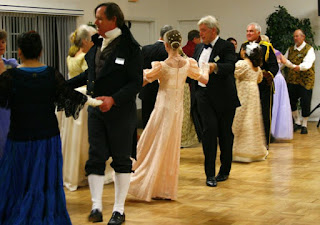You’ve probably
heard of Civil War reenactments, Renaissance fairs and even Viking festivals.
But here’s one that might prove new to you—it certainly surprised me. English
Country Dancing, commonly referred to as ECD.
From the Queen’s
Jig to the Minuet, all of that dancing in period dramas is not such a lost art
as might be supposed. Aside from the choreographers hired for regency films, a whole
population of enthusiastic English Country Dancers thrives in various ECD clubs
throughout the country. My mom uncovered one such organization called the San Diego
English Country Dancers which meets once a week and welcomes visitors for
lessons in these formal historical dances.
These balls often
involve regency gowns, britches with coattails, a fiddle and a pianist and a
large ballroom where lines of intrepid dancers learn the patterns and
gracefully relive the romantic social customs of 18th and 19th
century Britain.
A recovering
klutz, dancing has never been an incredible skill of mine. When I galloped on
stage like a pony during my first ballet recital, my parents decided that some
other extracurricular pastimes might be worth exploring. I returned to the
dancfloor in high school when a combination etiquette and manners with ballroom
dancing class called cotillion was mandated for my personal growth and
development. My parents hoped that I might learn how make conversation in a
social situation and eventually be able to talk to people—i.e. boys.
Needless to say,
the awkward sophomore me loathed the idea and dreaded these dances. But at the
end of the school year, it didn’t seem quite so awful any more, and I even
admitted that I had learned a few things. Come senior year of high school, I actually
requested to join cotillion again. I still fumbled my way through the waltz,
but I kind of liked the tango and the swing dances. And, as I quickly learned,
being a girl makes it a little easier to stumble your way through. After all,
girls can just follow their partners, and a good dancer who actually leads can
make even a klutz like myself feel pretty accomplished. (Of course, the reverse
is equally true, and the more I learned the more difficult it was to dance with
a confused lead.)
I’m still
uncomfortable with modern “wiggle” dances, but I sincerely like organized
ballroom steps and line dances. East-coast swing has the greatest number of
cool twists and turns, so it is consequently, grammatically and mathematically the best. Dancing turned out to be
not so heinous as originally feared. As I grew up a little bit, dancing came in
handy. It proved a capital excuse for holding the hand of a certain someone.
In Pride and Prejudice, all this dancing serves several
functions. First, it was an excuse to get all the young people together at a
party. Next, it allowed said folks a few moments of alone togetherness (granted
in a noisy room full of eyes watching them, but it was still some time to
talk—if the waltz didn’t leave you gasping for breathe). Several important
conversations in the novel take place over the form of a dance. It provides
Darcy an initial opportunity to neglect Lizzy but later offers a chance for him
to single her out.
www.sdecd.org
Even in the 21st
century, where all these social graces seem abandoned, dancing provides the
possibility of spending time with a partner who you like or simply enjoying the
fun art of movement. So a hearty thank you to history lovers like the English Country
Dancers of the world who work to preserve the virtues of dancing.







